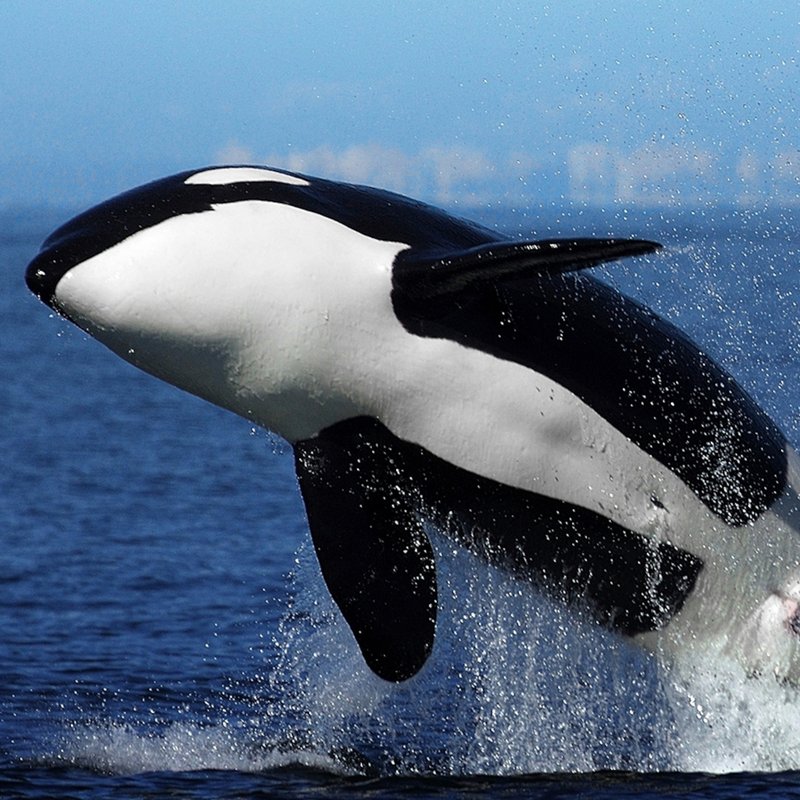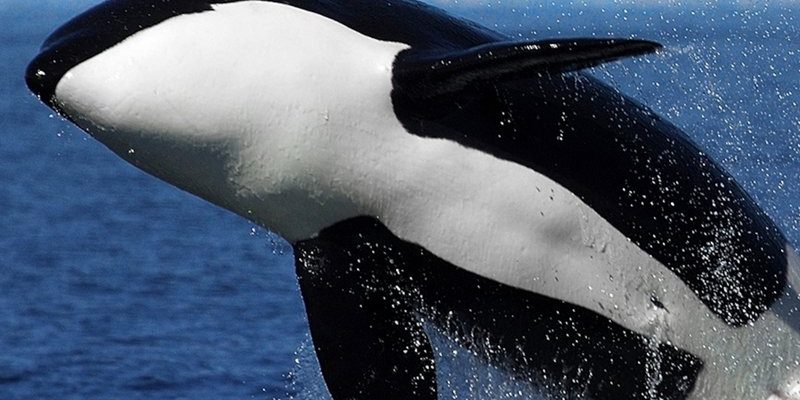
Orcas are often misunderstood. While the name “killer whale” might sound fearsome, it reflects their prowess as apex predators. They’re actually a part of the dolphin family, making them more closely related to friendly sea creatures than the fierce hunters they seem to be. This blog will explore ten captivating facts about orcas, shedding light on their complex behaviors, family structures, and remarkable intelligence.
1. Orcas Are Highly Social Animals
Orcas live in pods, which are tight-knit family groups that can consist of anywhere from a few individuals to over 40 members. Here’s the thing: these pods aren’t just random gatherings. They often consist of related individuals, like mothers, their offspring, and even grandmothers. This strong family bond helps them to hunt together and protect each other from potential threats.
A pod may hunt as a team, using sophisticated techniques that highlight their intelligence. For instance, they can create waves to knock seals off ice floes. Isn’t that incredible? Imagine a well-coordinated team working together to achieve a common goal. The social structures of orcas are complex, almost like a family reunion on the water!
2. They Have Unique Dialects
You might be surprised to learn that orcas have their own “languages.” Each pod has its own dialect, which consists of clicks, whistles, and pulsed calls. Just like regional accents in humans, these sounds can vary significantly between different pods. This means that orcas from one group might have trouble understanding the calls of another group.
Let me explain further: researchers have documented various calls that seem to serve different purposes, such as signaling distress or coordinating hunts. It’s like having secret codes that only family members know, making it essential for their communication and cooperation.
3. Orcas Are Apex Predators
When we say that orcas are apex predators, we mean they sit at the top of the food chain. They have no natural predators in the wild. Their diet is incredibly varied and can include fish, seals, sea lions, and even other whales. Isn’t that wild?
Here’s an interesting tidbit: orcas have been observed hunting in packs, working together to take down much larger prey, like blue whales. They even display different hunting techniques depending on the region they’re in. For example, orcas in colder waters may focus on seals, while those in warmer waters might prefer fish. Their adaptability plays a crucial role in their survival.
4. They Can Live a Long Time
Orcas have impressive lifespans that can reach up to 90 years in the wild, although this can vary between males and females. Female orcas tend to live longer, often surpassing 50 years, while males generally have shorter lifespans of around 30 years. This longevity is partly due to their close-knit social structures, which can enhance their chances of survival.
Now, consider this: just like humans, older orcas often take on leadership roles in their pods. They might share vital knowledge about hunting grounds and migratory paths, passing down wisdom from generation to generation. Isn’t it remarkable how their family dynamics mirror our own?
5. They’re Masters of Echolocation
Have you ever wondered how orcas hunt in the vast ocean, where visibility can be limited? Here’s where their incredible ability to use echolocation comes into play. Orcas emit sounds that bounce off objects in their environment, allowing them to locate prey and navigate through the waters.
It’s a bit like having sonar capabilities, helping them “see” their surroundings acoustically. This skill is particularly beneficial in murky waters where sight is not enough. Imagine being able to “see” your environment using sound waves—it’s a superpower in the underwater world!
6. Orcas Have Diverse Color Patterns
One of the most striking features of orcas is their distinct black and white coloration. However, did you know that their markings are as unique as human fingerprints? Each orca has its own pattern of spots and shapes, which can be used to identify individuals.
Researchers often track these patterns to study orca populations, movements, and behaviors. It’s much more than just a pretty coat; it plays an essential role in wildlife conservation efforts. Identifying individual orcas helps scientists understand their patterns and the challenges they face in the wild.
7. They Display Complex Emotions
Orcas are not just intelligent; they exhibit complex emotions as well. They’re known to show signs of grief when a pod member dies, often mourning their loss by staying close to the body for days. This behavior highlights their strong emotional bonds and social connections.
Take this into consideration: when an orca experiences the death of a family member, it’s not just a passing event. They seem to understand the significance of loss, much like we do. This emotional depth makes them all the more relatable and fascinating.
8. Orcas Are Found in Every Ocean
You might think of orcas as creatures primarily of cold waters, but they actually inhabit every ocean worldwide! Their adaptability to different environments—from the icy waters of the Arctic to the warm coastal regions—shows just how versatile they can be.
Understanding their distribution helps researchers identify habitats and behaviors specific to certain regions. So, whether you’re in the frigid north or the balmy equator, there’s a chance you might encounter these amazing whales. Isn’t it cool to think about how far they roam?
9. They Have a Varied Diet
Orcas are known for their diverse diet. While some pods prefer fish, others might target marine mammals. Their food preferences can be influenced by location and available prey. For example, transient orcas tend to hunt marine mammals like seals and even large whales, while resident orcas focus primarily on fish, such as salmon.
This variability means that orcas have developed different hunting strategies based on what’s available. It’s a bit like how some people might favor sushi while others prefer a classic cheeseburger. Their dietary choices are not just diverse but also tailored to their surroundings, showcasing their adaptability in the wild.
10. Conservation Status
Despite being at the top of the food chain, orcas face numerous threats today, including pollution, habitat loss, and depletion of their prey. Some populations are even considered endangered. Conservation efforts are crucial to ensure the survival of these incredible creatures.
By raising awareness and supporting sustainable practices, we can help protect the habitats that orcas rely on. Here’s the thing: every little bit counts. Supporting ocean preservation helps ensure that future generations can experience the wonder of orcas in the wild.
In conclusion, orcas are truly fascinating creatures with a rich tapestry of social dynamics, intelligence, and adaptability. From their complex family structures to their impressive hunting strategies, they remind us of the intricate connections within the ocean’s ecosystem. Understanding and appreciating orcas is important, as it not only enriches our knowledge but also highlights the need for their conservation. Let’s cherish these magnificent marine mammals and work towards ensuring a healthy future for them in our oceans.

